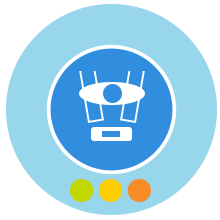Many parents choose convertible car seats because they grow with the child, saving mom and dad from having to upgrade with every growth milestone.
Convertible seats are designed to protect a wide range of children; from small babies to larger children. For smaller children, a convertible car seat is designed to be installed facing the rear of the car. As the child grows, the car seat “converts” to a forward-facing position for larger children. Weight ranges for convertible car seats vary dramatically. Always check your labels and instructions to make sure your child is the appropriate size for your car seat and installation position. Follow these guidelines when installing a convertible car seat:
- Always follow the information in both your car seat and vehicle owner’s manuals for important safety installation information.
- Before installing your car seat, be sure to adjust the car seat to fit your child. It is often easier to make these adjustments before the car seat is installed.
- For a rear-facing child, the shoulder straps should be at or just below the shoulder.
- For forward-facing child, the shoulder straps should be adjusted to be at or just above the shoulder.
- Fasten the harness on your child, making sure that the harness is flat and not twisted. To check if the harness is tightened correctly, pinch the harness strap material at your child’s shoulder. If your fingers slip, without gathering material, the harness is sufficiently tight.
- The back seat is nearly always the best place to install a car seat. The middle position is an excellent option. Always check your vehicle owner’s manual for appropriate seating positions to install your car seat.
- LATCH is a system that often makes installation easier. Convertible car seats can be installed with either the LATCH system or with the vehicle belt. Not every seating position in a car provides for a LATCH install. Always check your vehicle owner’s manual for this important information.
- For rear-facing installations, most car seats have an angle indicator line for horizontal reference. This reference line should be parallel to the ground. Note: If the vehicle is parked on a hill, this line needs to be parallel to the angle of the hill.
- In some cases, a tightly rolled towel can be used to help achieve the correct rear-facing angle.
- To tighten a rear-facing install, try to get into the vehicle. Position your body behind the back of the seat and push the car seat down into the vehicle seat while pulling up on the end of the belt, removing all the slack. A good install will not move more than 1 inch when pushed and pulled with reasonable force at the belt path.
- It is recommended that you use the car seat rear-facing as long as possible (but always in accordance with the manufacturer’s size limits).
- When ready to install forward facing, use your knee to push down on the seat as you tighten the belt.
- Periodically check the car seat, to make sure it has not shifted or loosened during use. For rear-facing installs, check the angle. For any install, check to make sure the seat does not move more than 1 inch when pushed and pulled with reasonable force at the belt path.
- Be sure to adjust the car seat to fit your child as they grow. Harness heights will need to move up. Buckle locations and other adjustments can also be made for a safer and more comfortable fit.

